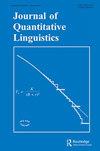西班牙语中指示/虚拟语气与疑问副词的转换
IF 1.7
2区 文学
0 LANGUAGE & LINGUISTICS
引用次数: 1
摘要
摘要本研究旨在分析西班牙语疑问句(acaso, posiblemente, probablemente, quiz本文章由计算机程序翻译,如有差异,请以英文原文为准。
The Indicative/subjunctive Mood Alternation with Adverbs of Doubt in Spanish
ABSTRACT This study aims to analyse the indicative/subjunctive mood alternation in Spanish sentences with adverbs of doubt (acaso, posiblemente, probablemente, quizá, quizás, tal vez, seguramente, a lo mejor, igual). To this end, this study statistically analysed the linguistic and social factors conditioning the mood alternation in sentences with adverbs of doubt. A total of 1278 tokens were analysed. Each datum was annotated with verb type, verb aspect, verb person, distance between the adverb and the verb, sex, age, region, and education level. To exclude confounding factors, multivariable logistic regression was conducted, and the analysis yielded significant odds ratios (ORs) for 10 items, including sex, region, education level, adverbs (posiblemente, probablemente, quizá, quizás, tal vez), aspect, and distance between the verb and the adverb. These results show that these adverbs can be divided into two groups, where posiblemente, probablemente, quizá, quizás, and tal vez are more likely to co-occur with the subjunctive than the adverbs acaso, seguramente, a lo mejor, and igual. Furthermore, this study has shown that each adverb differs in the likelihood of co-occurring with the subjunctive, and that social factors of speakers affect the mood selection. Thus, an analysis of mood alternations should include social and linguistic factors.
求助全文
通过发布文献求助,成功后即可免费获取论文全文。
去求助
来源期刊

Journal of Quantitative Linguistics
Multiple-
CiteScore
2.90
自引率
7.10%
发文量
7
期刊介绍:
The Journal of Quantitative Linguistics is an international forum for the publication and discussion of research on the quantitative characteristics of language and text in an exact mathematical form. This approach, which is of growing interest, opens up important and exciting theoretical perspectives, as well as solutions for a wide range of practical problems such as machine learning or statistical parsing, by introducing into linguistics the methods and models of advanced scientific disciplines such as the natural sciences, economics, and psychology.
 求助内容:
求助内容: 应助结果提醒方式:
应助结果提醒方式:


